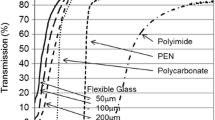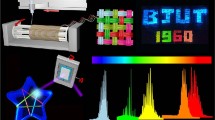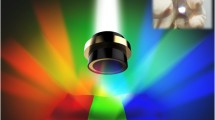Abstract
Flexible laser display is a critical component for an information output port in next-generation wearable devices. So far, the lack of appropriate display panels capable of providing sustained operation under rigorous mechanical conditions impedes the development of flexible laser displays with high reliability. Owing to the multiple scattering feedback mechanism, random lasers render high mechanical flexibility to withstand deformation, thus making them promising candidates for flexible display planes. However, the inability to obtain pixelated random laser arrays with highly ordered emissive geometries hinders the application of flexible laser displays in the wearable device. Here, for the first time, we demonstrate a mass fabrication strategy of full-color random laser arrays for flexible display panels. The feedback closed loops can be easily fulfilled in the pixels by multiple scatterings to generate durative random lasing. Due to the sustained operation of random laser, the display performance was well-maintained under mechanical deformations, and as a result, a flexible laser display panel was achieved. Our finding will provide a guidance for the development of flexible laser displays and laser illumination devices.

摘要
柔性激光显示是下一代可穿戴设备的重要组成部分. 到目前为止, 由于缺乏能够在机械条件下稳定工作的显示面板, 柔性激光显示的发展受到了阻碍. 随机激光器得益于多重反馈的工作机制可以承受机械变形, 是实现柔性激光显示面板的理想选择. 然而, 目前缺少一种通用的制备方法将随机激光器精确排布成高度有序的像素化矩阵. 为此我们提出了一种适用于柔性显示面板的全色随机激光阵列的构建策略. 在构建的微激光像素中, 多重散射可以提供持续的光学反馈回路, 使得随机激光可以稳定出射. 在机械变形下激光的性能也可以很好地保持, 从而实现高性能的柔性激光显示面板. 我们的构建策略将为柔性激光显示和激光照明设备的发展提供有益的参考.
Similar content being viewed by others
References
Zhao J, Yan Y, Gao Z, et al. Full-color laser displays based on organic printed microlaser arrays. Nat Commun, 2019, 10: 870
Chellappan KV, Erden E, Urey H. Laser-based displays: a review. Appl Opt, 2010, 49: F79
Zhou Z, Zhao J, Du Y, et al. Organic printed core-shell heterostructure arrays: a universal approach to all-color laser display panels. Angew Chem Int Ed, 2020, 59: 11814–11818
Park SI, Xiong Y, Kim RH, et al. Printed assemblies of inorganic light-emitting diodes for deformable and semitransparent displays. Science, 2009, 325: 977–981
Yokota T, Zalar P, Kaltenbrunner M, et al. Ultraflexible organic photonic skin. Sci Adv, 2016, 2: e1501856
Liang J, Li L, Niu X, et al. Elastomeric polymer light-emitting devices and displays. Nat Photon, 2013, 7: 817–824
White MS, Kaltenbrunner M, Głowacki ED, et al. Ultrathin, highly flexible and stretchable PLEDs. Nat Photon, 2013, 7: 811–816
Choi M, Bae SR, Hu L, et al. Full-color active-matrix organic light-emitting diode display on human skin based on a large-area MoS2 backplane. Sci Adv, 2020, 6: eabb5898
Choi MK, Yang J, Kang K, et al. Wearable red-green-blue quantum dot light-emitting diode array using high-resolution intaglio transfer printing. Nat Commun, 2015, 6: 7149
Kim TH, Cho KS, Lee EK, et al. Full-colour quantum dot displays fabricated by transfer printing. Nat Photon, 2011, 5: 176–182
Zhong Y, Liao K, Du W, et al. Large-scale thin CsPbBr3 single-crystal film grown on sapphire via chemical vapor deposition: Toward laser array application. ACS Nano, 2020, 14: 15605–15615
Gao R, Zhao M, Guan Y, et al. Ordered and flexible lanthanide complex thin films showing up-conversion and color-tunable luminescence. J Mater Chem C, 2014, 2: 9579–9586
Liang J, Chu M, Zhou Z, et al. Optically pumped lasing in microscale light-emitting electrochemical cell arrays for multicolor displays. Nano Lett, 2020, 20: 7116–7122
Shi L, Meng L, Jiang F, et al. In situ inkjet printing strategy for fabricating perovskite quantum dot patterns. Adv Funct Mater, 2019, 29: 1903648
Fang X, Yang X, Li D, et al. Modification of π-π interaction and charge transfer in ratiometric cocrystals: Amplified spontaneous emission and near-infrared luminescence. Cryst Growth Des, 2018, 18: 6470–6476
Cloutier SG, Kossyrev PA, Xu J. Optical gain and stimulated emission in periodic nanopatterned crystalline silicon. Nat Mater, 2005, 4: 887–891
Chen R, Tran TTD, Ng KW, et al. Nanolasers grown on silicon. Nat Photon, 2011, 5: 170–175
Zhang C, Zou CL, Dong H, et al. Dual-color single-mode lasing in axially coupled organic nanowire resonators. Sci Adv, 2017, 3: e1700225
Dong H, Zhang C, Liu Y, et al. Organic microcrystal vibronic lasers with full-spectrum tunable output beyond the Franck-Condon principle. Angew Chem Int Ed, 2018, 57: 3108–3112
Zhang Q, Su R, Liu X, et al. High-quality whispering-gallery-mode lasing from cesium lead halide perovskite nanoplatelets. Adv Funct Mater, 2016, 26: 6238–6245
Wang X, Shoaib M, Wang X, et al. High-quality in-plane aligned CsPbX3 perovskite nanowire lasers with composition-dependent strong exciton-photon coupling. ACS Nano, 2018, 12: 6170–6178
Lawandy NM. Coherent random lasing. Nat Phys, 2010, 6: 246–248
Wiersma DS. The physics and applications of random lasers. Nat Phys, 2008, 4: 359–367
Sun TM, Wang CS, Liao CS, et al. Stretchable random lasers with tunable coherent loops. ACS Nano, 2015, 9: 12436–12441
Hu HW, Haider G, Liao YM, et al. Wrinkled 2D materials: a versatile platform for low-threshold stretchable random lasers. Adv Mater, 2017, 29: 1703549
Zhu H, Shan CX, Zhang JY, et al. Low-threshold electrically pumped random lasers. Adv Mater, 2010, 22: 1877–1881
Redding B, Choma MA, Cao H. Speckle-free laser imaging using random laser illumination. Nat Photon, 2012, 6: 355–359
Wang YC, Li H, Hong YH, et al. Flexible organometal-halide perovskite lasers for speckle reduction in imaging projection. ACS Nano, 2019, 13: 5421–5429
Xu FF, Li YJ, Lv Y, et al. Flat-panel laser displays based on liquid crystal microlaser arrays. CCS Chem, 2020, 2: 369–375
Lin CH, Zeng Q, Lafalce E, et al. Large-area lasing and multicolor perovskite quantum dot patterns. Adv Opt Mater, 2018, 6: 1800474
Wang K, Du Y, Liang J, et al. Wettability-guided screen printing of perovskite microlaser arrays for current-driven displays. Adv Mater, 2020, 32: 2001999
Ren Y, Zhu H, Wu Y, et al. Ultraviolet random laser based on a single GaN microwire. ACS Photonics, 2018, 5: 2503–2508
Wang Z, Meng X, Kildishev AV, et al. Nanolasers enabled by metallic nanoparticles: from spasers to random Lasers. Laser Photonics Rev, 2017, 11: 1700212
Haider G, Lin HI, Yadav K, et al. A highly-efficient single segment white random laser. ACS Nano, 2018, 12: 11847–11859
Wang Z, Meng X, Choi SH, et al. Controlling random lasing with three-dimensional plasmonic nanorod metamaterials. Nano Lett, 2016, 16: 2471–2477
Li X, Wang Y, Sun H, et al. Amino-mediated anchoring perovskite quantum dots for stable and low-threshold random lasing. Adv Mater, 2017, 29: 1701185
Yakunin S, Protesescu L, Krieg F, et al. Low-threshold amplified spontaneous emission and lasing from colloidal nanocrystals of caesium lead halide perovskites. Nat Commun, 2015, 6: 8056
Wang Y, Li X, Song J, et al. All-inorganic colloidal perovskite quantum dots: a new class of lasing materials with favorable characteristics. Adv Mater, 2015, 27: 7101–7108
Protesescu L, Yakunin S, Bodnarchuk MI, et al. Nanocrystals of cesium lead halide perovskites (CsPbX3, X = Cl, Br, and I): novel optoelectronic materials showing bright emission with wide color gamut. Nano Lett, 2015, 15: 3692–3696
Dong H, Zhang C, Liu X, et al. Materials chemistry and engineering in metal halide perovskite lasers. Chem Soc Rev, 2020, 49: 951–982
Quan LN, García de Arquer FP, Sabatini RP, et al. Perovskites for light emission. Adv Mater, 2018, 30: 1801996
Chen R, Bakti Utama MI, Peng Z, et al. Excitonic properties and near-infrared coherent random lasing in vertically aligned CdSe nanowires. Adv Mater, 2011, 23: 1404–1408
Luo Z, Chen Y, Wu ST. Wide color gamut LCD with a quantum dot backlight. Opt Express, 2013, 21: 26269–26284
Arsenault AC, Puzzo DP, Manners I, et al. Photonic-crystal full-colour displays. Nat Photon, 2007, 1: 468–472
Deng R, Qin F, Chen R, et al. Temporal full-colour tuning through non-steady-state upconversion. Nat Nanotech, 2015, 10: 237–242
Acknowledgements
This work was financially supported by the Ministry of Science and Technology of China (2017YFA0204502), and the National Natural Science Foundation of China (21790364).
Author information
Authors and Affiliations
Contributions
Author contributions Zhao YS conceived the concept and planed the project. Zhao YS supervised the research. Hou Y designed and performed the experiments and prepared the materials. Hou Y, Zhou Z, Zhang C, Tang J, Fan Y and Xu FF carried out the optical measurements. Hou Y and Zhao YS analyzed the data and wrote the paper. All authors discussed the results and commented on the manuscript.
Corresponding author
Ethics declarations
Conflict of interest The authors declare that they have no conflict of interest.
Additional information
Yue Hou obtained her BSc degree from Lanzhou University in 2016. She is currently working on her PhD degree in Professor Zhao’s group at the Institute of Chemistry, Chinese Academy of Sciences (ICCAS). Her research interests are the photonic properties of micro/nanomaterials and their applications as miniaturized photonic devices.
Yong Sheng Zhao received his PhD degree in 2006 at ICCAS. After that, he joined the University of California at Los Angeles (UCLA) and Northwestern University as a postdoctoral fellow. In 2009, he returned to ICCAS as a professor of chemistry. His research interests include the controllable synthesis of low-dimensional organic materials, photophysical and photochemical processes, as well as the fabrication and performance optimization of photonic/optoelectronic devices.
Supporting Information
Rights and permissions
About this article
Cite this article
Hou, Y., Zhou, Z., Zhang, C. et al. Full-color flexible laser displays based on random laser arrays. Sci. China Mater. 64, 2805–2812 (2021). https://doi.org/10.1007/s40843-021-1664-0
Received:
Accepted:
Published:
Issue Date:
DOI: https://doi.org/10.1007/s40843-021-1664-0




